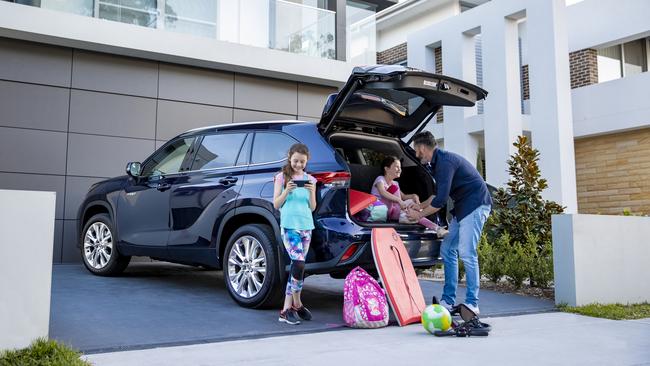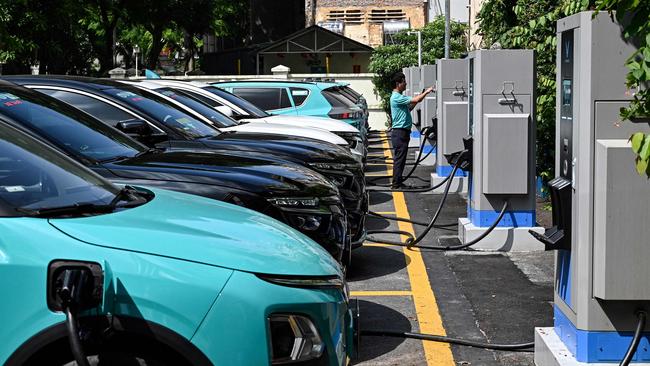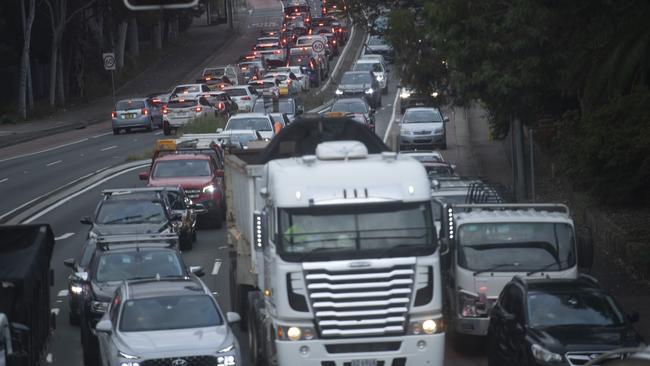Popular family hybrids slugged with ‘luxury’ tax, new emissions scheme to cost $155 million
Popular large family hybrids like the Toyota Kluger and Mazda CX-60 will soon be slugged with a new “luxury” tax.
Fed Budget
Don't miss out on the headlines from Fed Budget. Followed categories will be added to My News.
A $13-million-a-year regulator will be established to police the Albanese government’s new vehicle carbon emissions regulations, dubbed a “ute tax” by some critics, when the scheme starts next year.
Labor’s controversial New Vehicle Efficiency Standard (NVES), which the industry had warned could drive up the cost of the country’s most popular cars like the Ford Ranger by more than $10,000, will kick in on January 1, 2025.
Tuesday’s budget reveals the Albanese government will spend nearly $155 million over the next six years to get the NVES up and running “to support greater choice of fuel-efficient vehicles that will reduce motoring costs and transport emissions”.
“The New Vehicle Efficiency Standard will save Australians around $95 billion at the bowser by 2050 and reduce transport emissions,” budget papers state.
The NVES aims to reduce emissions from new passenger vehicles by more than 60 per cent by 2030, and roughly halve the emissions of new light commercial vehicles over the same period.
The scheme will put caps on total carbon emissions permitted across a manufacturer’s fleet, and will establish a trading scheme so carmakers can offset their penalties by buying carbon credits from other companies.
Manufacturers will not begin earning credits or penalties until July 1, 2025.
The government says the move brings Australia into line with other countries, but the car industry has warned that a five-year timeline for manufacturers to more than halve emissions is unrealistic.

The Albanese government first unveiled the proposed new rules targeting gas-guzzling utes and SUVs in February, but following weeks of sustained criticism announced a more relaxed NVES in late March.
In addition to delaying the start date of the penalty scheme by six months, the key changes included shifting some passenger car models such as the Toyota LandCruiser and Nissan Patrol to the light commercial category, and easing the emissions ceiling for light commercial vehicles.
“This legislation will mean Australian motorists are no longer at the back of the queue, no longer treated as second-class citizens,” Climate Change Minister Chris Bowen Bowen told reporters in March.
“No longer will Australia be in the ‘G2’ of Australia and Russia as the only two major economies without vehicle efficiency standards.”
Legislation for the NVES was introduced to parliament in March.
“This groundbreaking reform will ensure Australian motorists are able to save money at the bowser and choose from a wider range of more fuel efficient, modern vehicles that are cheaper to run,” the budget states.
The $154.5 million includes $84.5 million over five years to establish a regulator to administer the NVES, “including to capture emissions data, establish a credit trading platform and undertake monitoring and compliance activities, and to undertake further work to bring Australian vehicle standards into line with those of our peers”.
The government will spend $10 million on a national advertising campaign to promote the NVES.

Family hybrids stung by luxury tax
Meanwhile, popular large family hybrids like the Toyota Kluger and Mazda CX-60 and CX-90 will be hit with the 33 per cent Luxury Car Tax (LCT) after Labor tightened the fuel-efficiency threshold.
The change, first announced in December’s mid-year economic update, reduces the definition of a fuel-efficient vehicle for the purposes of the LCT from a maximum fuel consumption from seven litres per 100 kilometres to 3.5 litres.
The LCT is applied at 33 per cent on every dollar above $76,950, but for vehicles defined as fuel-efficient the tax kicks in at $89,332.
Several large hybrid models popular among families with more than two children will be captured under the new definition. The Mazda CX-60 has a fuel economy of 4.9 litres, the Kluger 5.6 litres and the CX-90 5.4 litres.
Budget papers show the LCT will bring in $1.29 billion this financial year before falling to $1.11 billion in 2024-25.
The change to the fuel efficiency threshold is expected to raise an additional $155 million over two years from July 1, 2025, with total LCT receipts over that period forecast to rise to $2.47 billion.
Carmakers and dealers have previously expressed outrage at the announcement, describing it as a blatant cash grab and calling for the “archaic” tax to be abolished.
“The Luxury Car Tax, as [former Treasury boss] Ken Henry said, is a tax that has no economic merit and we should eliminate it,” said Tony Weber, chief executive of the Federal Chamber of Automotive Industries (FCAI).
“Especially as we’re pushing people into more expensive technology through the New Vehicle Efficiency Standard, more families are going to have to buy more expensive cars to comply with that legislation, and then putting a Luxury Car Tax on top is not a good idea.”
Mr Weber said the government’s focus should “be on affordability”.
“Some people have limited choice because they’ve got large families to move around, three or four children, they need vehicles of these sizes,” he said. “The [CX-60, CX-90 and Kluger] are incredibly fuel-efficient vehicles, I’m not sure most people would describe them as ‘luxury’ cars.”
Australian Automotive Dealer Association (AADA) chief executive James Voortman said the LCT “should have been abolished when we stopped making cars in Australia”. “Instead, the tax continues to raise hundreds of millions of dollars and now it’s being increased on a range of fuel-efficient vehicles,” he said.
“There will be families buying a large hybrid vehicle, thinking that they are saving fuel or doing the right thing by the environment, only to find that they are now going to be captured by the LCT.”

$60 million for EV charging
The NVES funding includes $60 million to support the installation of electric vehicle charging infrastructure at car dealers.
The money will come from the existing Driving the Nation fund under the Department of Climate Change, Energy, the Environment and Water, which has been tasked with delivering a “backbone” national EV charging network on key highway routes at an average interval of 150 kilometres, connecting all capital cities.
“The Australian automotive industry is on the verge of a major transition with the commencement of the NVES in 2025,” Mr Voortman said.
“It is critical that our budget settings support this transition by encouraging the uptake of low-emissions vehicles, reforming automotive taxation and investing in skills and infrastructure. There are massive investments required by our industry to transition to net zero and the government should consider measures to encourage those investments.”
A report commissioned by the AADA last month suggested the investment needed in charging infrastructure was estimated to exceed $1 billion for franchised new car dealers.
“New car dealerships will be at the forefront of rolling out EV chargers as manufacturers require them to install chargers in their showrooms and service departments as part of their franchise agreements,” Mr Voortman said at the time.
“Many consumers considering taking the leap and buying a new EV are looking for their dealer to provide education about the vehicle and the charging experience. The availability of EV chargers in dealerships means vehicles in stock can be charged and made available for test drives while buyers can also see first-hand how charging works.”
Mr Weber said further investment in charging infrastructure was “critical”.
“We need the confidence that people who buy EVs know that there is a charging infrastructure to support them,” he said.

No fuel excise cut or road user charge
The government has resisted calls to provide additional relief to motorists via a temporary cut to the fuel excise, and has also punted on implementing a nationally consistent road-user charge.
Treasurer Jim Chalmers said this week the budget would not “chase the petrol price up and down”.
The fuel excise is a tax levied by the federal government on petrol and diesel bought at the bowser. Motorists currently pay 49.6 cents in excise for every litre of fuel they purchase.
“We want to help motorists because we know that they’re under pressure, but we just think that there are more effective ways to do that elsewhere in the budget, rather than the sort of multi-billion dollar outlays we’ve seen in the past when it comes to the petrol excise,” Dr Chalmers told Sky News.
The government had earlier also ruled out implementing a road user charge for EVs, which the car industry has argued would be fairer than the current system.
As the number of people driving EVs grows, falling fuel excise will mean less revenue to pay for road transport infrastructure.
Mr Weber said the government should overhaul various taxes like the LCT and import tariffs and replace them with a road user charging system.
“Obviously it’s been ruled out but the road user charging is something we think needs to be addressed at some point in time,” Mr Weber said.
“Our view is that it should be technology neutral. We should examine the way in which motorists are taxed and remove a whole raft of those inefficient taxes and apply one more efficient road user charge.”
Australian Automobile Association (AAA) managing director Michael Bradley told The Australian last week he would be looking to see “whether the government has a plan to ensure that everybody who uses our roads is paying their share toward their upkeep”.
“While the AAA strongly supports the shift to zero and low-emission vehicles, fewer people paying more tax while others pay no tax at all is not sustainable, or equitable,” he said.
The introduction of the NVES is estimated to decrease fuel excise revenue by $470 million over four years from 2024-25, “owing to lower motoring costs resulting from greater availability of more fuel efficient vehicles”, the budget states.
Total excise from petrol, diesel and other fuel products is still forecast to rise every year over that period to a total of $112.32 billion.
More Coverage
Originally published as Popular family hybrids slugged with ‘luxury’ tax, new emissions scheme to cost $155 million





